STOCKING ALLERGY OTCs
Don’t let patients sneeze past the product
THE SHORTAGE OF PHARMACISTS
Rebuilding the most accessible community health care

Don’t let patients sneeze past the product
Rebuilding the most accessible community health care
Choosing what’s right for you

Quality Choice focuses on providing your business with over-the-counter health, beauty, and wellness products in multiple categories. A leader in the industry with over 25 years of experience, we provide products with everyday savings for our customers.
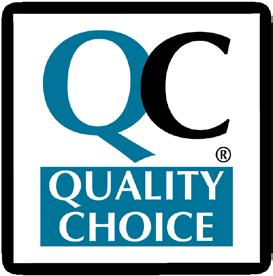

• Gross margins as high as 89%
• An extensive selection of categories with over 700 SKUs
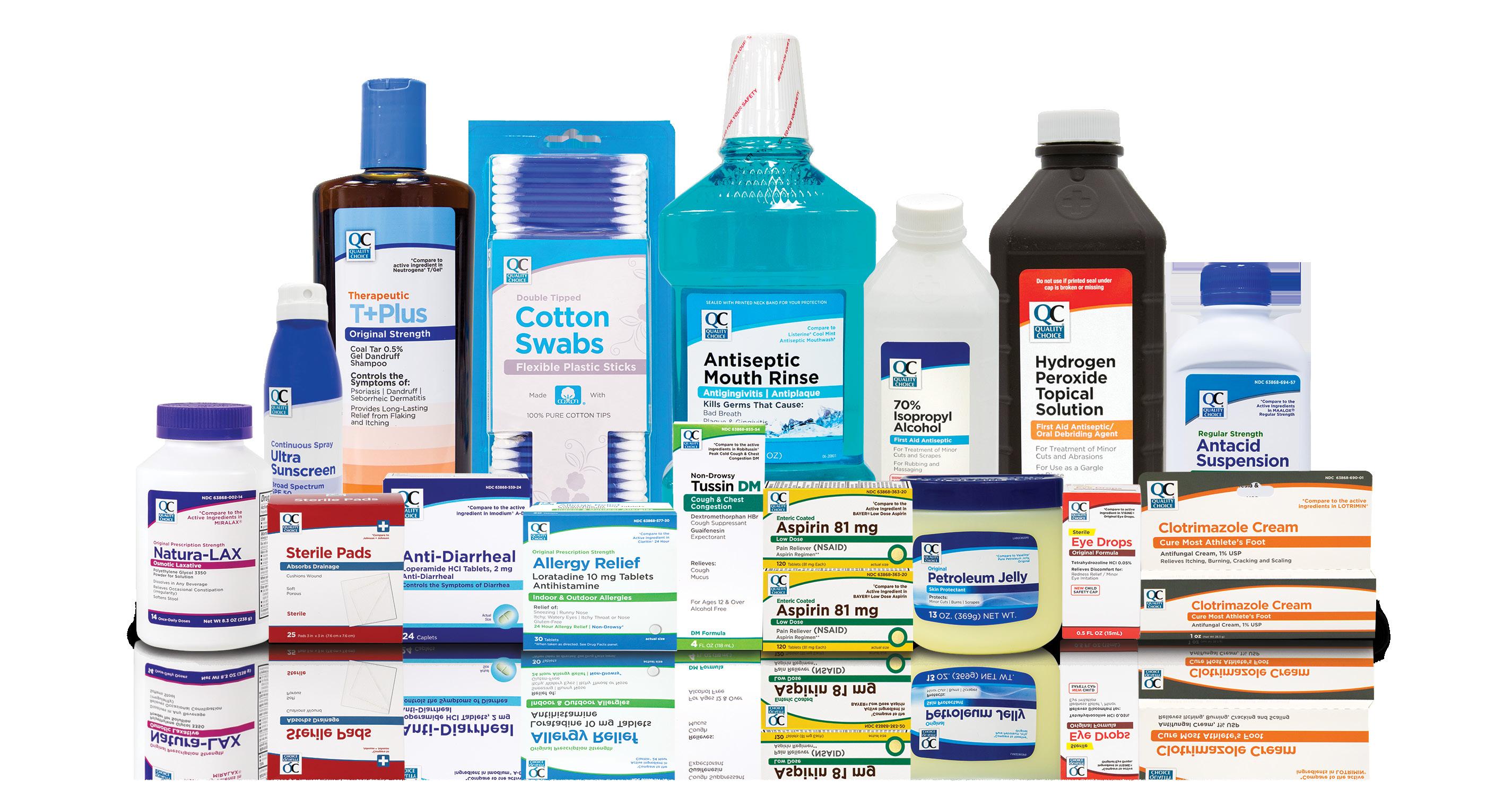
• Free merchandising and marketing services
• Everyday savings for consumers with a 100% satisfaction guarantee
• Assistance with filling orders when your wholesalers are out of product stock
• Expedited order processing & shipping
Need assistance with your Quality Choice order or have questions?
Contact Customer Care 800-333-8097 ext. 5707 | customercare@pbahealth.com


PUBLISHER & EDITORIAL DIRECTOR
Matthew Shamet EDITOR
Gina Klein
ART DIRECTOR
Lisa Doherty
CONTRIBUTING WRITER
Cecilia Vigliaturo INTERESTED
elements@pbahealth.com




On average, people spend nearly seven hours online every single day. As a small business, that means going digital is best for reaching potential new patients.
Did you know you can be an important business partner? If you know how to promote yourself to healthcare providers, you’re on your way.
The word “audit” is an anxietyridden word no one wants to hear. However, it’s safe to assume that your pharmacy will eventually be the subject of an audit.
Bo Garmon Loan Officer (479) 856-3001
bgarmon@ffb1.com
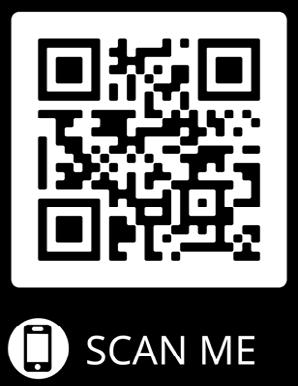
Drew Hegi, MBA Loan Officer/ Pharmacy Owner (601) 594-6237


dhegi@ffb1.com
When you partner with First Financial Bank, we’ll get to know you and your business inside and out. Whether you’re starting your first pharmacy or growing your business, we have the first-hand industry expertise to create a wide range of financial products tailored specifically to your business. Because, not all pharmacies are the same, and you should have a bank who knows your business. First Financial Bank – In the business of YOU.

Schwanda Flowers, PharmD Managing Director (501) 672-5040

sflowers@ffb1.com
Bob Graul R.Ph, MBA Business Development Consultant


“They treated us like we were their only clients, even though we knew we weren’t.” – Thomas & Ruth, Albuquerque, NM
Anew diabetic medication has entered the scene, and it may be approved for weight loss. If so, this Eli Lilly drug could perhaps become the best-selling drug of all time. But will those who need it be able to afford it?
The drug, tirzepatide (Mounjaro™), has experts confident that the Food and Drug Administration will approve it sometime next year. If it does, it’ll join a couple of other popular—and expensive— weight-loss drugs on the market (Saxenda® and Wegovy®). The difference between the three is that tirzepatide targets more than the GLP-1 receptor. It also mimics glucose-dependent insulinotropic polypeptide (GIP), another hormone involved in insulin secretion.
Tirzepatide causes weight loss in several ways. It signals to the brain that you’re full, so you eat less. It also slows the movement of food through your stomach, so you feel full longer, and it lowers blood sugar. The levels of weight loss following tirzepatide treatment near those that are typically only achievable through bariatric surgery. After six months, body weight reduces by 30 percent and the weight loss continues up to two years.
These newer treatments have made it possible to safely decrease body weight by more than 10 percent through pharmaceutical methods. These newer treatments also improve cardiovascular health.
All three drugs are given as injections, and clinical trials have shown that they’re highly effective for weight loss. What’s more, the three of them work in a similar way. They’re a class of drugs called GLP-1 agonists. These mimic hormones known as incretins, which lower blood sugar and curb appetite.
The cost for tirzepatide is unknown right now; however, outside experts estimate it could be priced similarly to a month’s supply of Wegovy (around $1,500), or Saxenda (around $1,350). Researchers estimate the cost for tirzepatide could be about $13,000 annually, or about $1,100 per month.
These drugs, with the exception of Mounjaro and its recent approval, are covered by most insurance. However, this isn’t always the case. Obesity drugs aren’t always covered by insurance because they carry a unique stigma. Most physicians view obesity as a behavioral problem, not a medical one. In fact, insurance companies often need more proof of the benefits of anti-obesity drugs than they do for other medications. And while some insurers may offer
coverage for one of the weight-loss drugs, they often restrict access only to patients who meet a certain threshold, such as a BMI greater than 30. But what if the covered drug doesn’t work for them? Everyone responds differently to any given weight-loss drug. So, if the drug their insurance covered doesn’t work for them, they’re typically out of luck. There are usually no other options left.
The same goes for private insurance, where coverage for antiobesity medications is sporadic. Treatments are often confined to the most expensive plans. Medicare will not cover them because anti-obesity drugs aren’t mandatory. However, some states have opted to include them.
“These new medications with an indication for weight loss can be effective especially for patients who can’t necessarily exercise and diet,” said Nick Smock, President and CEO of PBA Health, PharmD, MBA, President of FPN, Vice President of APhA, and member of various state pharmacy and national associations. “This can enhance our profession and practices, not only dispensing the medication, but this is a huge opportunity for pharmacists to implement weight-loss and healthy-living programs into their clinical or consulting practices. Adding a weight-loss program to your offering would benefit numerous patients of the independent pharmacy.”
Whatever the upfront costs may be, scientists stress the importance of addressing obesity. By doing so, it could allow healthcare systems to save immense amounts of money by reducing numerous conditions that are linked to the disease.
No matter what, healthy eating and exercise will always be a part of treatment. These drugs are a promising addition to the mix. They act through biological mechanisms, which gives some researchers hope that this will help people understand that a person’s body weight is often beyond their control through lifestyle changes alone
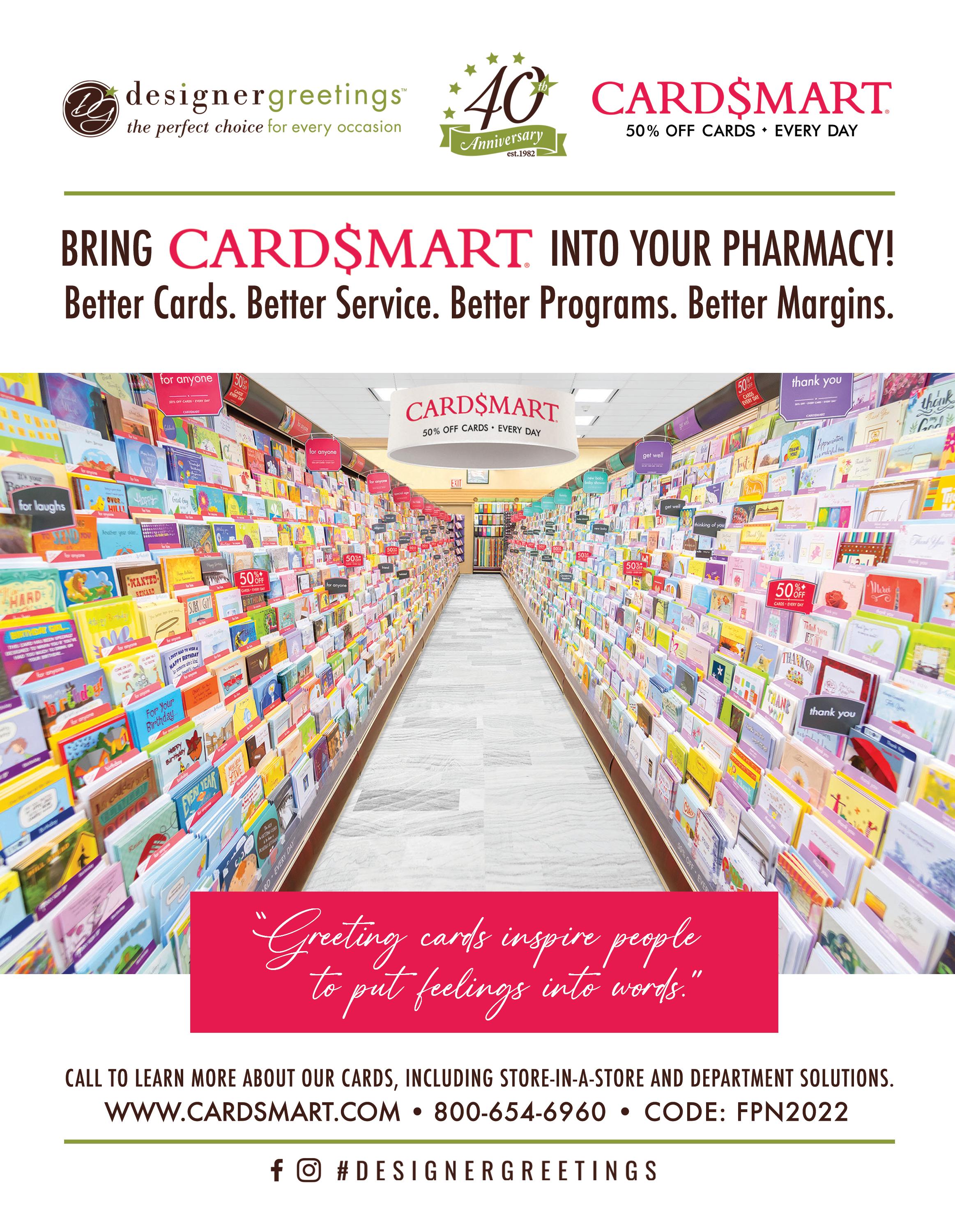
Making 1 + 1 = 3
When you think of developing a partnership with other organizations, you might think of your local hospital or community center. But it’s prime time to think differently and act bigger, albeit in a smaller way.

How?
First, think of your community pharmacy as a brand, which is necessary if you want to successfully compete against the chains and big-box stores. Second, think big and notice how national brands team up.
Have you bought a Legos ® set, eaten at a Taco Bell ®, or worn a pair of Nike ® sneakers recently? These are just three brands known for creating successful collaborations with other popular brands.
Why all the cross-promoting?
"The pace of change in today’s retail market—and retail health care, in particular—has never been more disruptive,” said Dave Wendland, Vice President, strategic relations and member of the owner group at Hamacher Resource Group,
a trusted resource partner in exploring and executing retail solutions for brands, retailers, distributors, and more. “When changes occur as quickly as they do today, it’s more important than ever to continually innovate and look for the next opportunity. One way to do that is through relationships and partnerships.”
Now it’s time to think local. What local or regional neighbors can you team up with?
“Test the waters by partnering with brick-and-mortar stores in your area,” advised Wendland. “Run co-marketing campaigns, feature each other’s products and services to increase sales, and host co-sponsored events to drive foot traffic. You can always start small and then build on those relationships with larger-scale initiatives.”
Successful collaborations can yield profits that extend well beyond your balance sheet. You might learn new tactics, come up with innovative ideas, and work with successful businesspeople you never would have met otherwise. Even an unsuccessful partnership might at least teach you what you don’t want to do.
Most of all, think of the increased value to your patients and community. “Your patients gain confidence because you’ve done the legwork for them, which creates patient loyalty,” said Wendland. “You’re also tapping into another locally owned business, which helps your community rise.”
Take your time, do your research, and consider the type of relationship that would be mutually beneficial. And consider the partnership more as an informal, handshake agreement and less as a letter-of-the-law legal contract.
For example, imagine a partnership with your local florist. You could send flowers to patients recently released from the hospital or refer their loved ones to the shop. That florist could then send customers to your pharmacy for their healthcare needs.
“To remain relevant in any industry, companies need to stretch their horizons,” said Wendland. “My advice to pharmacy is to define where it can bring value to its customers, assess how to achieve that, fill the void with partners, and then build larger-scale initiatives.”
Are the partner business values and business practices aligned with yours?
Does the partnership truly bring “new” value to your customers?
Do the products and services complement one another?
Will the partnership attract new customers and deliver differentiated products and services?

“TO REMAIN RELEVANT IN ANY INDUSTRY, COMPANIES NEED TO STRETCH THEIR HORIZONS.”
Invite regional growers to a oncemonthly farmers market in your store’s front-end area or parking lot. You’ll underscore the importance of diet (food is medicine) and local or organic choices. As the event grows, invite local chefs to demonstrate or offer samples. You might harvest a few farmers as new customers.


Pet products produce pawfit! Partner with your local vet to fulfill compounded pharmaceuticals, your town’s pet store to offer health-and-wellness pet products, your independent bookstore to feature training guides, or a pet-sitting or dogwalking business (even if they’re highschool students making a buck).
Boost your vaccination business by working alongside a local office-supply store, school system, or homeschooling community. Spotlight over-thecounter (OTC) items like first-aid items, elastic bandages, or anti-bacterial wipes. You could also include information or business cards for tutors, music teachers, or activity coaches.

Adding healthy treats to your pharmacy operations will make your patients smile. Work with a local bakery to come up with a dozen (or more) treats that might be gluten-, sugar-, or nut-free. You could sample them in your shop and then offer classes as part of your pharmacy’s diabetes education or weightloss programs, as well.


Is a high-school team going to state? Is it graduation or wedding season? Ask a local photographer to help you properly create a spot in your shop for local customers to take selfies or group photos. Gather inexpensive props and have some fun! As for competitions, it’s not just football or basketball— remember debate, STEM, dance clubs, and 4-H or FFA programs.
Dave Wendland, Vice President, strategic relations and member of the owner group at HRG, shared some imaginative partnership ideas.


Are you on the fence about adding a private label to your community pharmacy?
You may think it’s not worth the hassle due to meager reimbursements, DIR fees, and frustrating clawbacks. But even with those, prescription sales make up 95 percent of your business on average. That leaves a measly five percent for the front end. So, why bother?
“A private-label line increases profit,” said Kim Leach, National Account Manager at CDMA. “In fact, private-label products are more profitable than national brands.”
Private labels are cash sales, which go into your bank. This means no one will ask you for money at the end of the quarter. They provide greater margins and instantly contribute to your cash flow, giving OTCs a dual benefit that prescription sales can’t provide. Plus, shopping private labels saves consumers an average of 28 to 33 percent.
“The highest profit margin SKUs tend to be in analgesics, vitamins, cough and cold, first aid, and digestive. As a private label, all categories offer very good margins," Leach said. “Some of the other categories that offer good margins include batteries in general merchandise, hand and body, foot care, and implements."
Here are some things to consider before you revamp your shelves with your own private label:
• Pinpoint the types of patients who frequent your pharmacy and which ones are your target market.
• Make a mental note of what OTC products they purchase most.
• Scan your front-end products to see if any complement the prescription medications your patients already picked up.
• Be sure you have enough staff and the proper systems in place for inventory management.
• Walk your store to make sure the design and layout are conducive to those who like to browse and may want to buy non-prescription items.
• Prepare your team to engage with and help patients in the store.
Once you’ve made up your mind to adopt a private label, how do you move those items off the shelf?
Start with prices. If you’re pricing the products yourself, simply take the brand price and reduce it by 20 to 25 percent. Your customers will appreciate those savings, and your pharmacy will still earn a nice profit because the privatelabel products cost you less than the brand.
Increase your bottom line with these ideas:
There’s a reason your customers shop at your independent pharmacy. They know they get the best care and advice from your staff. If you spot a customer purchasing a brand name, educate them on your private-label OTCs. Let them know they offer the same results for a lower price.
Believe it or not, most people don’t notice price differences while shopping. They’re in a hurry. They simply spot the product they need, grab it, and continue on their way. Help your patients notice the differing prices by printing shelf talkers that compare the brand name with the private-label product.
Do you have a customerloyalty program?
Incorporate your private label OTCs into it and encourage customers to buy private-label items so they can earn additional loyalty points on their qualifying purchases.
Prioritizing your private label in your merchandising is important, so placing it in a location where it’s seen is vital.
“Your private label is typically offered in the front end, to the right of the matching national brand. By merchandising this way, you allow your patients to compare the ingredients and price against the national brand. This philosophy came from the fact that most people are righthanded and tend to grab to the right,” Leach said.
Leach also adds that merchandising products on a clip strip, endcap, floor display, or PDQ display is an excellent way to have your private-label brand merchandise in a hightraffic area. It also captures the sale from a consumer who may not be walking down the OTC aisle.
By educating your staff on your private-label products, they’ll soon become your private-brand ambassadors who will help increase your profitable sales.
Understand what you want your brand to reflect. Pinpoint the missions and values that define your brand’s identity. What message do you want to send to your patients? Get to know your competitors. This will help you avoid building a brand that’s just like theirs.
This will help you understand their concerns and needs. It will also help you develop your private-label brand and decide upon the products to start stocking first.
The private-label supplier you choose matters. Differences between suppliers lie in the quality and success of your brand. Find a supplier who offers products that will meet the needs of your patients.
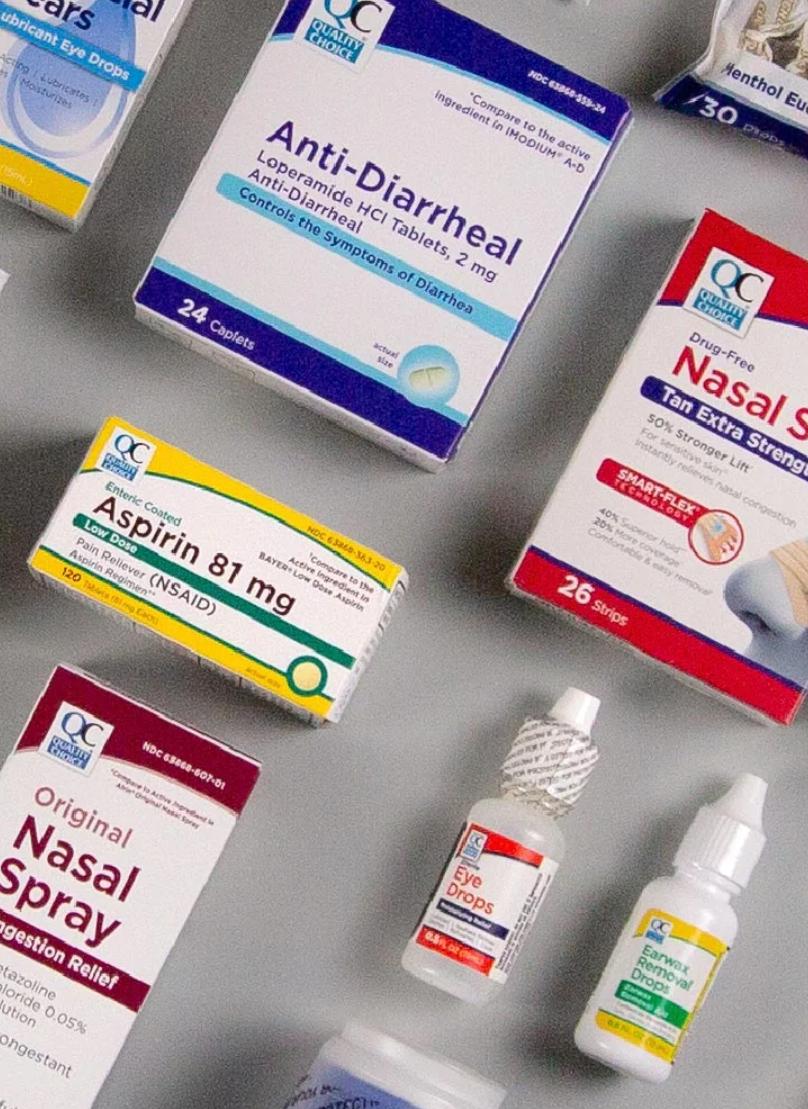
It sounds easy, but there is a lot to consider when making a label. You’ll need to include the name and brand of the product; its primary uses; the medication ingredients; the correct dosage; who the medication is/isn’t suitable for; expiration dates for the products; storage instructions; any essential warning information; and a graphic.
"BY PLACING A ‘COMPARE TO’ STATEMENT ON THE FRONT, UPPER RIGHT OF THE PACKAGE, YOUR CUSTOMERS CAN BE ASSURED IT’S THE EXACT SAME PRODUCT MEETING ALL
THIS CLAIM.
"
FLAVORx








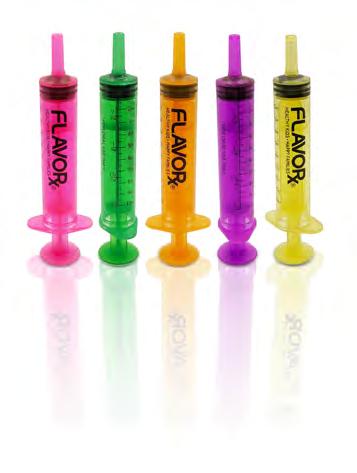
Order

The pharmaceutical industry is quite complex. And due to its colossal size, it can be a challenge for industry leaders to stay on top of quality standards, which can result in counterfeit medications. And it has. In fact, as much as 10 percent of medications in the world are counterfeit.
The Food and Drug Administration (FDA) enacted the Drug Supply Chain Security Act (DSCSA) in 2013. At that time, it set a 10-year timeline for full implementation; and now, the deadline is only months away. November 27, 2023, marks the final milestone.
The initiative aims to secure the supply chain with endto-end, unit-level traceability. Every link in the chain has had to undergo changes in how it receives and moves drugs, whether it’s through new scanning systems, information databases, packaging, or procedures.
The initial deadline in 2018 found many companies unprepared due to a lack of guidance from the FDA along with confusion about the requirements. Since then, the FDA has issued several pieces of draft guidance to help companies prepare for implementation in 2023.
“There are two titles to the Act,” said Fred Liner, Director of Information Technology at PBA Health. “The first title is a set of requirements. All members of the supply chain are to essentially verify the products, which means any product they receive within the prescription drug

space. That includes protocols for examining, protocols for quarantining, any questions they have with legitimacy of the product, and requirements to report concerns with the validity of any product that they receive to the manufacturers or wholesalers. That’s Title One, and that went into effect almost immediately.”
The second title requires pharmacies to accept pharmaceutical products exclusively from authorized trading partners with a DSCSA-compliant product identifier. You’re also required to receive, store, and provide product-tracing information. However, you can only accept prescription drugs accompanied by the transaction information, transaction history, and transaction statement. For products under suspect investigation, pharmacies are required to verify that the suspect product’s standardized numerical serial number, lot, expiration date, National Drug Code (NDC), and Global Trade Item Number (GTIN) for at least three packages—or 10 percent—of the ordered product (whichever is greater) matches what’s in the system. In other words, compare what’s in the physical to what’s in the electronic.
At this point in time, you should already have the processes, procedures, and equipment in place to fulfill your part of the DSCSA. If you’re not 100 percent confident, however, here’s a checklist listing every DSCSA requirement for dispensers.
As a pharmacist, you are required to verify that all trading partners have a valid license and are registered per federal and state law. You should also have protocols in place or routine verification for all new trading partners and be sure to regularly audit current trading partners. Search the WWD/3PL database at FDA.gov to verify licensure.
Pharmacies must:
• Only accept product if the previous owner provides the transaction information, transaction history, and transaction statement (“3Ts”)
• Capture and maintain the “3Ts” for six years from the date of the transaction
• When selling or loaning product, provide the “3Ts” to the subsequent owner, unless the subsequent owner is a patient
You are required to identify and report suspect products that may be illegitimate. You should have procedures in place to:
• Identify suspect product currently in inventory and among new products
• Inform trading partners about suspect product
• Quarantine suspect product from regular inventory
• Remove illegitimate product from the supply chain
• Promptly notify your upstream supplier after determining that a product is illegitimate
• Altered product information
• Looks different than product on shelf
• Missing information on the label
• No “Rx only” symbol
• Bubbling on label
• Lot numbers or expiration dates do not match the outer/inner container
• Foreign language
• Missing or wrong package inserts
• Damaged or broken seal
• Open package
• Different product name than FDA-approved version
THE “3Ts ”
TRANSACTION INFORMATION
This information includes the name of the product, strength and dosage form, NDC, container size, number of containers, transaction date, shipment date, name and address of the seller and buyer, and lot number, if applicable. This can all be provided in paper or electronic format.
TRANSACTION HISTORY
This is a paper or electronic statement that includes the transaction information for each prior transaction of the product back to the manufacturer.
TRANSACTION STATEMENT
This is a paper or electronic attestation transferring ownership of the product.
A SOLUTION THAT DSCSA ALLOWS IS FOR YOUR SUPPLIER TO PROVIDE THIS DATA ARCHIVE.
A product identifier is a standardized graphic that includes:
• The product’s standardized numerical identifier (the NDC and a unique alphanumeric serial number)
• Lot number
• Expiration date
All of this information must be in both human- and machine-readable formats. The machine-readable format has to include a two-dimensional data matrix barcode for packages and a linear or two-dimensional data matrix barcode for homogeneous cases.
Products that are exempt:
• Blood or blood components intended for transfusion
• Certain radioactive drugs or radioactive biological products
• Imaging drugs
• Certain intravenous products
• Any medical gas
• Homeopathic drugs
• Drugs compounded in compliance with sections 503a or 503b of the FD&C Act
More than half of the manufacturing space has already missed their hard date, and while signs of readiness have been observed as of late, many trading partners are still lagging in bringing together their capabilities in order to meet the 2023 interoperability goals.

Full DSCSA compliance has many implications for companies, which is why it’s important to start preparing now. Those that fail to comply may be liable for heavy fines and other penalties from the FDA.
(As this Act goes live, there will be some additional regulations. Look for updated articles from PBA Health.)
"ALL MEMBERS OF THE SUPPLY CHAIN ARE TO ESSENTIALLY VERIFY THE PRODUCTS, WHICH MEANS ANY PRODUCT THEY RECEIVE WITHIN THE PRESCRIPTION DRUG SPACE."
$9.99 Retail / $4.50 Cost Each Deal Price $648 144 Pair @ $4.50 a Pair
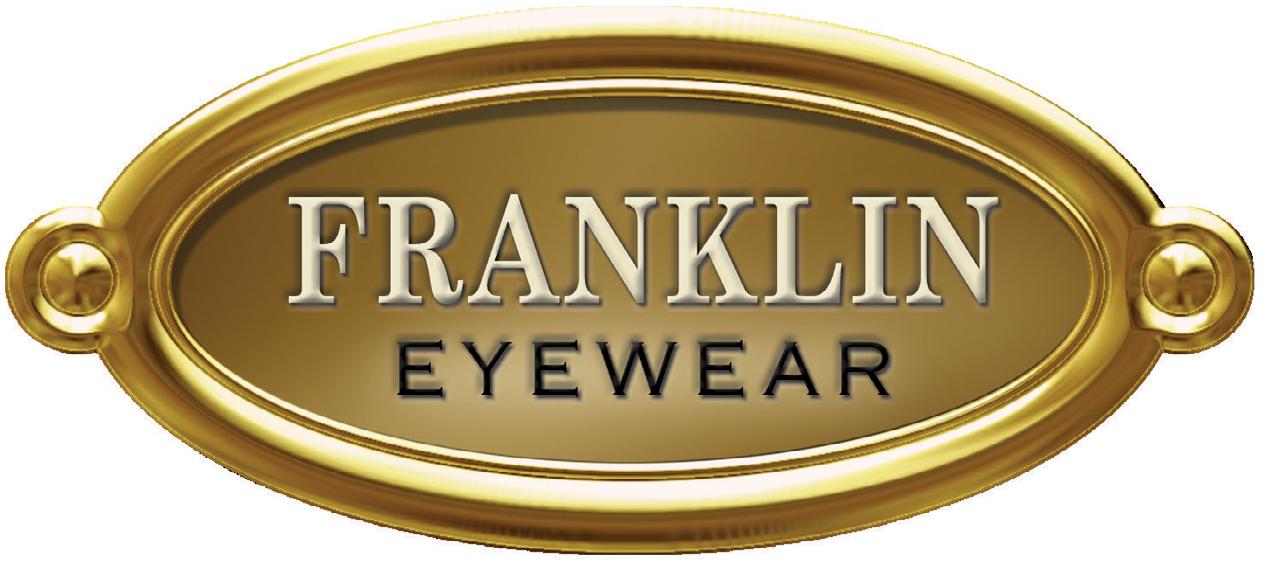
Sunglasses price tags color coded by category

Reading glasses price tags color coded by strength

Your pharmacy software system is the core of your pharmacy, making everything you do a little bit easier. However, as newer models enter the market and a flux of new patients stand at your counters, it may be time to upgrade so you can keep up with your workload.
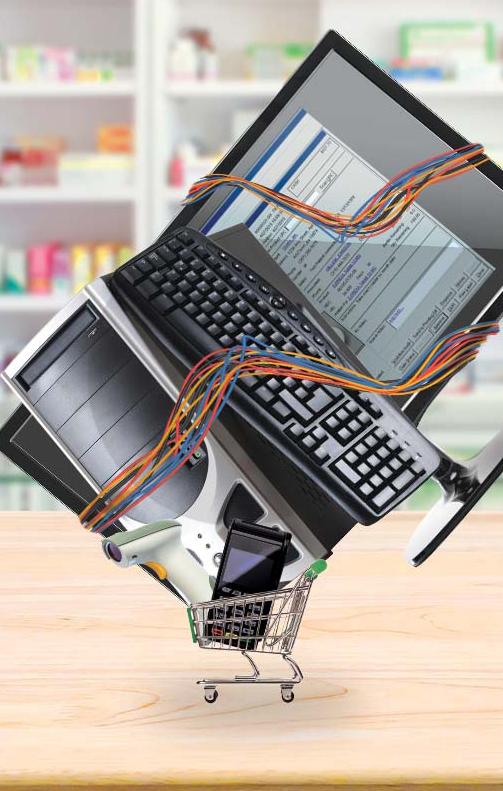
Searching for the perfect pharmacy software system can be vexing. Whether or not you’re new to the pharmacy scene, there is quite an array of options, and change can be scary. But if you know that your current software is no longer helping your store like it used to, finding something new will lead to exciting innovations. Every vendor offers something different, and naturally, some are better than others. But where do you start?
The first thing to remember when you’re in the market for a new software system is that there are different types of computer systems to choose from. Once you know which system will serve your pharmacy best, you’ll be ready to decide on options.

• WEB-BASED ORDERING SYSTEMS: These systems are often provided by drug wholesalers. This type of system allows pharmacists to order medications on a wholesaler’s website.
• PERPETUAL INVENTORY SYSTEMS: These involve tracking and recording the quantity of medications continuously as the prescription is filled and dispensed. By doing this, the medication is automatically removed from inventory, and you always have updated stock information.
• AUTOMATIC DISPENSING SYSTEMS: These machines automatically count and dispense pills for a pharmacist. More complex systems will also print the label and apply it to the bottle.
In a nutshell, your pharmacy software system is a collection of options that manage your pharmacy’s operations. It tracks the status of the supply of drugs and provides the function of audit trails. The software allows you to control supplies and track the levels of stock, which allows you to make informed decisions for your brick-and-mortar.
“When evaluating which management system is best for your pharmacy, be sure it includes a fully integrated point-ofsale solution, workflow clinical tools for completing MTMs and other opportunities, a robust system for eCare plans, and as many patient engagement tools as possible for connecting with customers in between visits,” said Scott Meadows, Director of ProfitGuard Strategic Markets at PBA Health.


Like you, every pharmacy is different in its own way. You may have similar services, but each community has a different demographic of people and characteristics. This influences the types of services you offer, your store’s branding, and the way you market your services. It also helps you determine what type of pharmacy you have (i.e. retail, specialty, long-term care, or multi-store).
Look online and research all of the independent pharmacy software providers and narrow down your options. Find their website and social-media platforms, and get an idea of what kind of company they are by reading reviews. More than half of people who read online reviews admit that they trust them as much as a personal recommendation from family

Are you unable to interact with your new software vendor and feel like just a number? Then they’re not for you. Inevitably, you’ll need customer support when you’re first starting out and even after, so waiting around on the phone is not where you want to be.
You don’t want to have to switch systems every year because you purchased a system that you outgrew. Software that will grow with you lets you work smarter, not harder. The system you choose should be easy to customize to meet your store’s current needs.

“ You have to have a really good checklist and know what you need now, and you need to be able to see what the potential future holds for you.”
–Scott Meadows
Perhaps you’d like your software system to interact with callers to gather information and route or forward the call to the correct destination. This is called interactive voice response (IVR).
“In a very simplified system, you call the pharmacy and there’s an automated attendant that speaks to patients. It has an interface with the pharmacy system so it can look up the refill numbers. It then goes through to the pharmacy system into a queue that the pharmacy technicians see. It lets them know the patient needs her prescription refilled,” Meadows said. “IVR makes it easier for the customers, and it’s one less phone call for the staff. The more integration, the better. You want a robust system. The IVR takes the workload off. However, it has to interface properly with the system.”
Here are some additional benefits of an IVR system:
• OUTBOUND PATIENT MESSAGING: The system automatically informs patients through text when their prescriptions are ready for pickup, when it’s time to refill, or even when certain vaccines are available with a marketing blast through IVR.
• NO INTERRUPTIONS TO WORKFLOW: The IVR will handle your calls and requests, allowing you and your staff to keep working. It’ll also minimize the manual refill requests.
• REFILLS THROUGH MOBILE APP AND WEBSITE: Some IVR companies will create a custom mobile app for your pharmacy. Patients can download it from the app store and request refills, set medication reminders, and more.
• ADVANCED LEVEL REPORTING: This will allow you to get an idea of your refill requests, call volume, call duration, call hang-ups, and much more.
• CHECK Rx STATUS: Patients can check their prescription status by interacting with the IVR.
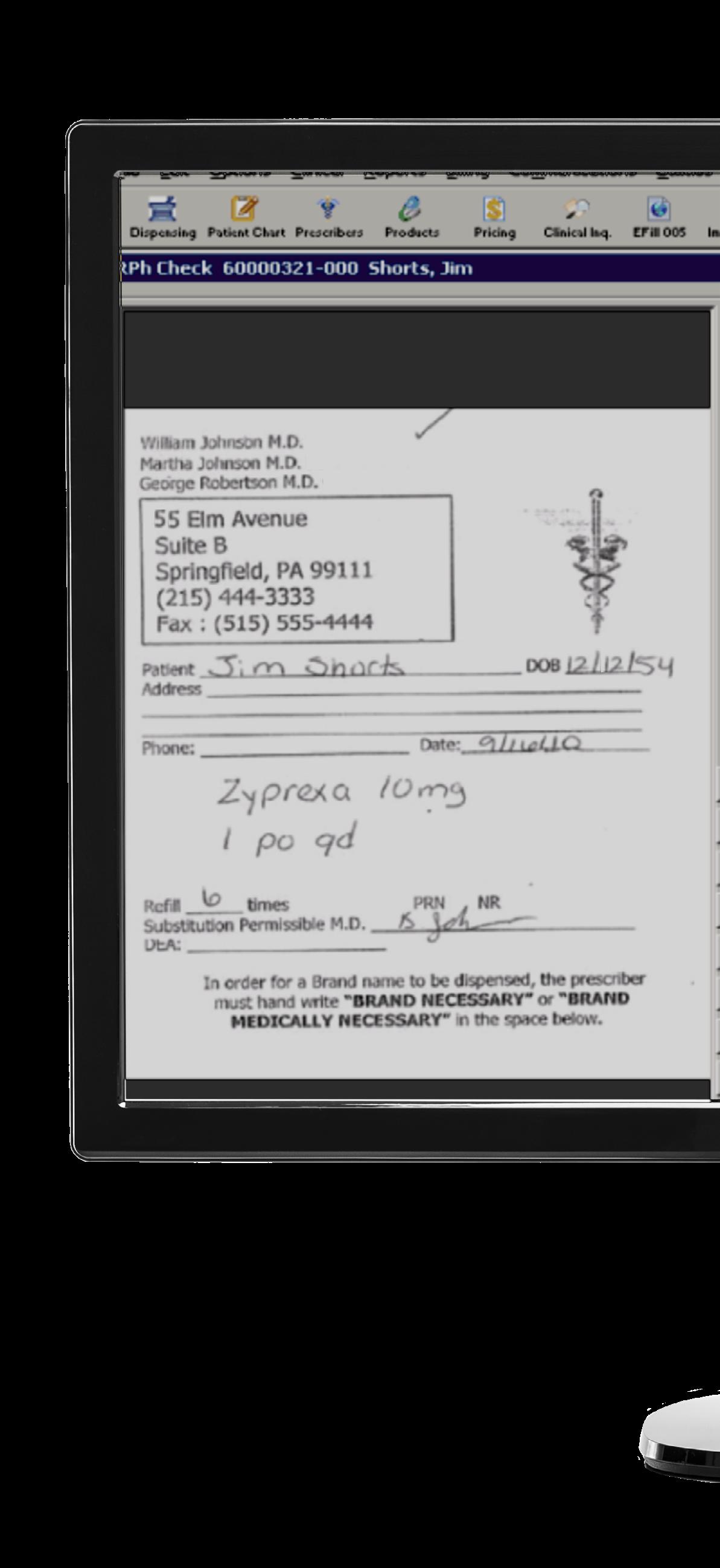
• CONTACT PATIENTS: An IVR can contact patients to keep up to date with their contact info and preferred method of contact.
If you’re thinking about adding an IVR system to your pharmacy software, do your research and be ready for a hefty price tag. Most IVR vendors will also charge you an upfront license or installation fee.

“IVR MAKES IT EASIER FOR THE CUSTOMERS, AND IT’S ONE LESS PHONE CALL FOR THE STAFF. THE MORE INTEGRATION, THE BETTER. YOU WANT A ROBUST SYSTEM.”
When you’ve pinpointed the pharmacy management system (PMS) you’d like to purchase, the next step is to evaluate price quotes. As you speak with each vendor, you’ll be given their own quote of how much you’ll pay for the software and whatever else is included in that cost estimate. Each vendor’s quote will differ. Break down each quote and compare your options equally. It’s important to know what you’re getting with the cost of your new pharmacy software.
With a pharmacy software system, you can eliminate potential processing errors. The system automates purchasing and reduces the amount of time your staff spends on manual tasks with features such as point of sale (POS), image scanning, and e-prescribing. These features automate the jobs of data entry and payment and prescription processing.

Run your pharmacy with features such as expiry alerts, purchase tracking, and automated sales operations.
With a PMS system, you’re able to offer vast knowledge and advice to customers by suggesting appropriate generic substitutes for prescriptions. Pharmacy solutions also enable you to send automatic notifications for refilling medications and setting up such things as loyalty programs.
Many pharmacy solutions enable customized reports and data visuals using integrated business intelligence tools.
Listed below are some of the top pharmacy software vendors most independent pharmacies choose for their business: (organized by percentage of market share)
One of the newer systems on the market was founded in 2007 and quickly moved to the top. Their mission is to “Save and Revitalize Independent Pharmacy.” They also produce the weekly Catalyst Pharmacy Podcast, which features leaders and innovators in the industry.
Features: automated prescription dispensing, bulk patient process, DIR fee management, five-star reporting and improvement, mobile apps and add-ons, and cloud fax
Founded in 1986, the company’s mission is to help pharmacies enhance patient care, increase patient safety, and improve profitability.
Features: automated prescription dispensing, pharmacy task management, advanced bin management, five-star dashboard, AWP reclaims, and text and email patient alerts
Founded in the early 1980s, Rx30 initially began as an independent software company. Rx30 and ComputerRx joined together in 2016 in order to form a strategic partnership. Both have been acquired by Transaction Data Systems (TDS) and now operate under one umbrella.
Features: workflow management, automated prescription dispensing, claims processing and reconciliation, enhanced reporting, medication synchronization, scheduling, and telehealth
ComputerRx started in the early ‘80s as a standalone software product. It then joined forces with Rx30 to operate under one place. TDS’s mission is to be dedicated to the success of independent and community pharmacies.
Features: customizable workflow, inventory and automatic ordering, claims processing and reconciliation, customizable reporting, point-of-sale integration, and medication synchronization
Also known as Best Computer Systems, BestRx was founded in 1985. The company’s mission is to deliver affordable, easy-to-use, tailored pharmacy software solutions.
Features: customizable workflow, interactive patient profiles, two-way messaging, built-in compliance, multidose packaging, advanced telehealth
DigitalRx is a Windows-based platform that provides a onestop comprehensive pharmacy management solution.
Features: retail point-of-sale, inventory management control, long-term care, accounts receivable, reconciliations, and electronic prescribing via Surescripts
Micro Merchant Systems was founded in 1990 and offers a pharmacy management solution called PrimeRx. It highlights its full line of pharmacy products on their Pharmacy Software Podcast Series, which is featured on the Pharmacy Podcast Network.
Features: customizable workflow, automated refill management, bin management, medication synchronization, automatic data backups, and wholesale cost comparisons
QS/1 released the first computerized management system for independent pharmacies in 1977. Their mission is to stay in lockstep with community pharmacists. QS/1 produces the QCompass Podcast that aims to help community pharmacies.
Features: advanced security solutions, prescription processing queue, customizable labels, inventory management, immunization reporting, and medication therapy management (MTM)
Operating since the early 1800s, McKesson also sells a pharmacy management solution called EnterpriseRx.
Features: web-based pharmacy management, centralized prescription processing, automated patient communication, patient data insights, medication synchronization, and mobile delivery
(Source: pharmacysoftwarereviews.com)
Don’t be tempted to look at the total costs at the bottom of the page when comparing price quotes. Look at the line items on each quote and figure out what’s included in each estimate. You don’t want to just look for the lowest initial price. A cheaper system may save you some money at first, but as you continue to run your pharmacy, you’ll notice the financial opportunities you could have had.
When it comes down to it, you just need to ask for the “real” monthly cost. You have every right to ask questions and know what your actual expenses will be if you decide to go with a vendor’s software system. Check out all the demos from a variety of vendors and compare equally. Be sure you know what you’ll get for your money. Most importantly, determine if the software’s capabilities will be a valuable investment for years to come.

Think about how the software system will set your pharmacy up for success. When a system has the right features, it’ll save you more money in the long run. Listed below are some common costs you’ll likely encounter when purchasing your pharmacy software that may not have been in your initial quote.
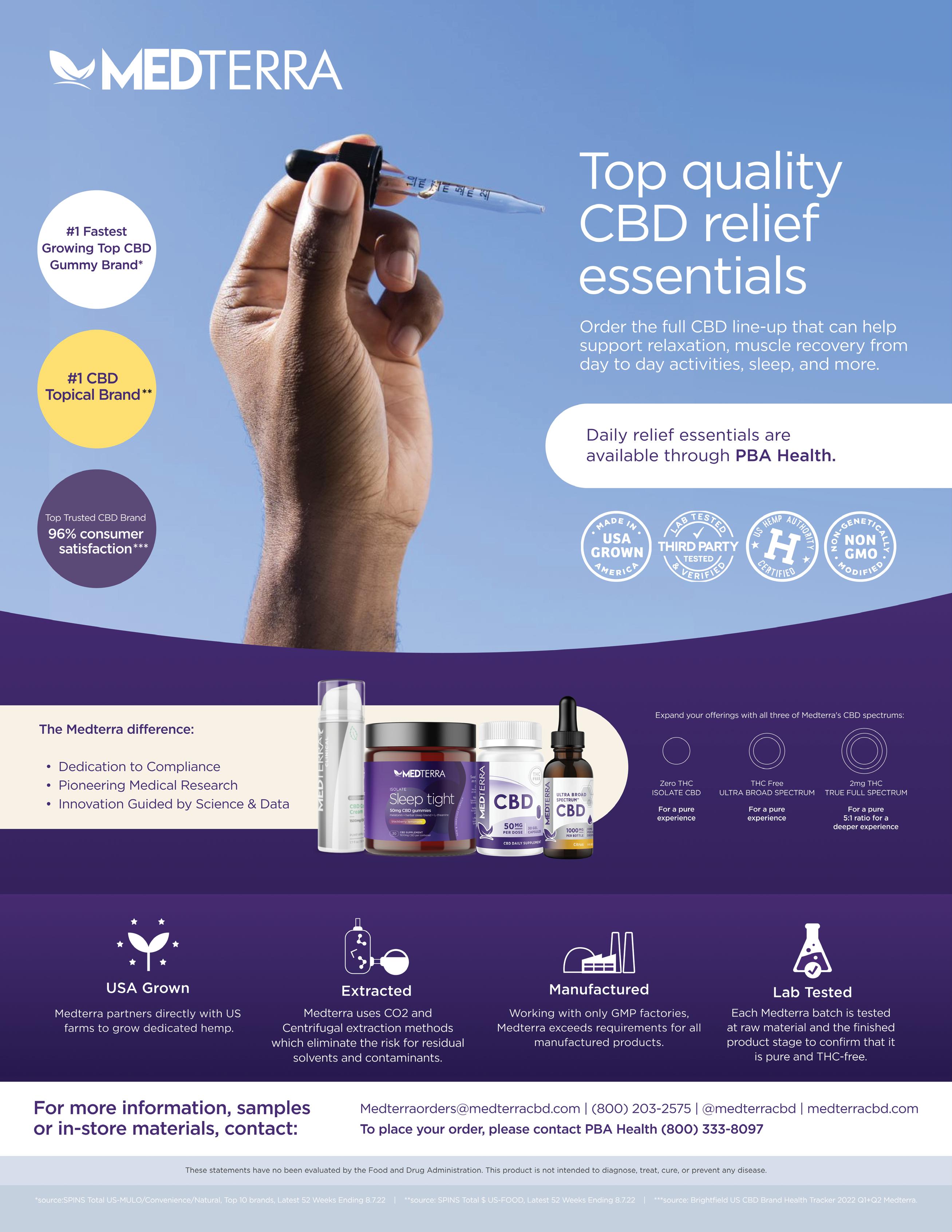
You'll likely need to buy some additional hardware because each software vendor has a list of minimum hardware requirements to run their software.

Find out if data conversion, software installation, and staff training fees are already included in your price quote.
This is important for independent pharmacies. You’ll need a reliable support tech to help in the everyday operations of your store. Check to see if support fees are already included.
What is the pricing for transaction fees such as eScript fees and claim fees? These are typically a “pertransaction” fee that’ll depend on your pharmacy’s operations.
“WHEN EVALUATING WHICH MANAGEMENT SYSTEM IS BEST FOR YOUR PHARMACY, BE SURE IT INCLUDES A FULLY INTEGRATED POINT-OF-SALE SOLUTION, WORKFLOW CLINICAL TOOLS FOR COMPLETING MTMS AND OTHER OPPORTUNITIES, A ROBUST SYSTEM FOR ECARE PLANS, AND AS MANY PATIENT ENGAGEMENT TOOLS AS POSSIBLE FOR CONNECTING WITH CUSTOMERS IN BETWEEN VISITS.”

The sniffles and sneezes of allergy sufferers will soon be entering your pharmacy. That is, if they haven’t already.
More than 50 million Americans—and many of your patients—suffer from allergies. Because of that, spring is one of your busiest over-the-counter (OTC) seasons. This is the time for allergy sales to skyrocket. But only if you stock your OTCs where patients can easily spot them.
The number of allergy sufferers who use OTCs has increased over the years, which means more patients will be entering your pharmacy in search of self-care options to calm their seasonal allergies. But are your shelves ready? If you aren’t sure how to get top sales out of the allergy category in your pharmacy’s front end, listed below are some helpful tips on allergy marketing, buying behaviors, and advertising.
Allergy relief: This should be the focal point of your front end. Organize all of your allergy products and treatments on endcap displays and planograms. That way they’re easy for your patients to find. Many patients may not know about new allergy products that have moved to OTC. So, encourage your staff to take the time to help patients choose the right OTC allergy-relief products.
Antihistamines at the top. Antihistamines are at the top amongst OTC allergy medications. They’re even favored more than decongestants. Feature various antihistamines in your pharmacy’s front end. This gives your patients options for relief.
You can help patients compare the features of different antihistamines, such as:
• How long they’ll take to start working
• How long they’ll last
• What symptoms they help
• Side effects
It’s a good idea to do this with decongestants and pain relievers, too, to help patients select the product that will alleviate their symptoms.
Usage depends on location. Allergy product sales may depend on your location. Use your pharmacy’s geographical location to tailor your endcaps and front-end displays to patients’ needs.
Are you in the Northwest region of the country? You may want to prominently feature decongestants. You can
also add pain relief to the display to capitalize on this buying trend.
If you’re located in the West, you may also want to feature sunscreen along with allergy-relief products in order to make the most of your display.
Effects of advertisements. Shoppers will seemingly purchase at least one product over another as a direct result of advertising. That’s why you need to use signage, planograms, and displays from manufacturers.
Store displays and product layouts should be as customer friendly as possible. During the shelf-placement process, items that are commonly purchased together should be positioned close to one another. For example, customers who purchase decongestants may also need OTC acetaminophen for a congestion headache or petroleum jelly to apply to their sore nose from blowing it so much.
Remember to have more than one allergy display in your store, and place them in different spots. You may think creating only one display to house the allergy medications will suffice, but in reality, it won't. You also need to change the location of your displays every so often. Place them in different spots around your front end—even if your storefront is small. Customers might walk right past a big display of decongestants by the front door, but then pick up a bottle when they see a smaller display near the pharmacy counter. Remember: when customers stop noticing the displays, you stop making profit.
Planograms are also helpful. There are retail planograms available specifically designed for pharmacies. A planogram is a diagram that visually depicts how products can be ideally organized and displayed on shelves. Using planograms can help you design a layout that encourages your customers to shop and makes it easy for them to find items they need.
Maintaining the appearance of your overall store will make your allergy OTC displays inviting. Simple enhancements like bright lighting, wide aisles, attractive signage, and modern décor will improve the overall look of your front end and create a better store experience for your patients. Make sure everything is clean and orderly.
A common pitfall for community pharmacies is to stock one or two items of a wide variety of front-end products.
This will leave your patients thinking one of two things: the pharmacy is out of stock on a lot of items, or your pharmacy is going out of business. Stocking fewer varieties and more products will help avoid the confusion. You’ll also want to find out what other pharmacies in your area are offering as far as OTCs. Then, look for gaps or niche items that you can provide. Be different. From specific brands of supplements to higher-quality products, you can set your OTC products apart from the competition.
Keep in mind that almost 50 percent of all customers check a store’s inventory online before they even step into the store. This means that if you aren’t building an online presence and syncing your OTC inventory, you may be missing out on much-needed foot traffic. So, update your pharmacy website or create a Pointy page to appear in Google searches. Pointy from Google integrates directly with Rx30 and ComputerRx. They keep your inventory updated online. To upload your items to your custom Pointy page, you just use the handheld barcode scanner to start appearing in local Google searches and compete with the larger retailers in your area.
LIP BALM TISSUES
EYE DROPS
NASAL STRIPS
NASAL CLEANSING POTS
SALINE SOLUTIONS
While educating your patients on medications to alleviate their seasonal allergies, don’t forget to remind them how to avoid allergy triggers to pollen or molds. Here are some great tips to share from the Mayo Clinic:
• Keep doors and windows closed during pollen season.
• Avoid hanging laundry outside — pollen sticks to sheets and towels.
• Use the air conditioning in your house and car.
• Consider an allergy-grade filter in your home ventilation system and change it regularly.

• Avoid outdoor activity in the early morning when the pollen counts are highest.
• Avoid outdoor activity on days with a high-pollen count.
• Stay indoors on dry, windy days.
• Use a dehumidifier to reduce indoor humidity.
• Use a high-efficiency particulate air (HEPA) filter in your bedroom and other rooms where you spend a lot of time.
• Avoid mowing the lawn or raking leaves.
• Wear a dust mask when cleaning house or gardening.
• Wear glasses or sunglasses when outside to limit pollen from getting in your eyes.






Whether you’re in the market to purchase your own independent pharmacy, or if you just need financing for upgrades or a remodel to your current store, finding the right pharmacy business loan can seem daunting. The good news is there are loans out there for small businesses just like yours through the Small Business Administration (SBA).
Pharmacies have the potential to be quite profitable when compared to other businesses in the healthcare industry. But they’re also much more expensive to start. It’s been estimated that it’ll take $300,000 in working capital to acquire or start your own independent pharmacy. If you’re already a pharmacy owner, you may just need additional financing to expand or purchase supplies, remodel your store, or invest in new opportunities. But where do you start?
Conventional banks provide pharmacy business loans. However, their eligibility criteria can often be hard to match if you’re just starting out. Your best bet is to look into pharmacy business loans backed by the Small Business Administration (SBA). Most independent pharmacies require this type of loan rather than a conventional loan. SBA loans work better for both the pharmacy and the lender. They offer a guarantee on part of the loan for the lender. For pharmacies, SBA loans require significantly less for a down payment, usually 10 percent instead of 25 percent.
There are several SBA pharmacy loans you can consider. Remember, though, that considerable capital is required to both start a new pharmacy or to acquire a running independent pharmacy.
If you’re wanting to acquire an existing business or start up a new pharmacy, this type of loan is a great option to consider. The highest loan amounts are offered under this program. This makes it possible for you to venture into the pharmacy business with adequate funds.
You can borrow a total of $5 million through an SBA 7(a) loan program. The funds can be used to purchase inventory and merchandise for your store, and you can use them to help meet your working capital requirements. You can also use the funds to acquire an existing business, buy out a partner, or to obtain real estate to build a new pharmacy.
• Be small as defined by the SBA
• Operate for profit
• Be engaged in or propose to do business in the United States or its possessions
• Have reasonable invested equity
• Demonstrate a need for the loan proceeds
• Be able to use the funds for a sound business purpose
• Not be delinquent on any existing debt obligations to the U.S. government
• Not find alternative financial resource before seeking financial assistance
(Source: ffb1.com)
What you may not know is that you can even refinance your current business debt with pharmacy loans. With the SBA, there’s a cap on interest rates, so you won’t have to pay more than 2.75 percent over the base prime rate.
An extension of the SBA’s 7(a), SBA Express loans are especially for business owners who want quick approval of their applications. The maximum loan amount is $500,000. This can be plenty to open an independent pharmacy in most U.S. cities.
You can use the funds to meet working capital needs and to buy needed merchandise and equipment.
Repayment terms can be spread out up to 10 years, and interest rates can be combined with the prime rate with
an up to six-percent spread.
Now that you know what they are, how do you obtain an SBA loan? First of all, you’ll need to pay a guarantee fee, which depends on the loan amount and closing costs from the lender. These are typically rolled into the loan. You’ll then fill out an application and hand over the much-coveted documents to your lender.

Lenders will delve into your financial records and other business documents before they agree to lend to you. Be sure the following documents are in good order before heading to the bank:
• Last three years’ tax returns on the business
• Most recent income statement and balance sheet on the business
• Last three years’ personal tax returns
• Personal financial statement
• Credit report (ordered by the bank once application is received)
Rates aren’t the only factor to consider when choosing a lender. The most important thing is to choose a lender or bank you’re comfortable dealing with. Be sure they specialize in independent pharmacy. You want them to understand your business and be a partner for you down the road as you grow and have additional needs.
If you’re pursuing an SBA loan, a preferred SBA lender will expedite the loan process. Preferred lender status allows banks to issue their own approvals instead of having to wait for SBA approval.
SBA loans are a great fit for independent pharmacies like yours. The key is to choose a bank with expertise in the industry. Make sure they’re a Preferred Lender Program (PLP) lender who will provide you with the personal service you need.
Don’t get lost in the jargon.
These assets are physical and measurable, such as cash, accounts receivable, inventory, property, and equipment.
These assets aren’t physical or quantifiable. They include the pharmacy’s brand name, customer base (or goodwill), and any patents or proprietary technology.
This formula calculates net income after all interest, taxes, depreciation, and amortization have been accounted for. This formula is the most widely used method when determining the value of a pharmacy and the cash flow ability of the business.
Working capital is essential for independent pharmacies. Working capital refers to cash on hand to manage day-to-day operations and inventory purchases.











































You see them as more than that. You see them as what they are your neighbors and even your friends. It’s this mutual trust and understanding, along with exceptional customer service, that you’ve built your business upon.

Like you, VaxServe appreciates the importance of strong partnerships. It’s values like this one, which you instill through your day-to-day interactions with patients, that will strengthen our partnership with you.




At VaxServe, we offer quality service and educational resources along with vaccines at a competitive price.














As pharmacy lines get longer, so do your hours behind the counter. Since the early days of the pandemic, numerous technicians and pharmacists left their jobs due to exhaustion and burnout, which has led to a shortage of them working in community settings. But you stuck around, adding more hours and stress to your job in your independent pharmacy.
Like many other pharmacists, you’re overwhelmed with challenging conditions such as staff shortages, dealing with pharmacy benefit managers (PBMs) hiking the costs of prescriptions, lowering reimbursements, and ongoing inflation. And unlike other small businesses, you can’t raise the prices on prescription medications to make up for higher costs because of PBMs.
“PBMs are looking at product, and they’re lowering what they pay you without really connecting what all the pharmacist has to do to dispense that product,” said Dale Smith, RPh, MA. “They’re looking at the product and not willing to pay the pharmacists for all the work that they’re doing. To get that drug to the patient, it can sometimes take hours on the phone.”
The shortage of pharmacy technicians has also been a difficult problem. The vacancy rates for technicians more than tripled across a three-year period. According to a 2022 poll conducted by the National Community Pharmacists Association (NCPA), more than 88 percent of respondents said finding pharmacy technicians was their top problem, followed by front-end staff at 56 percent.
Some community pharmacies have turned to several measures to maintain their operations because they don’t have enough staff to get everything done. Pharmacists are picking up the slack to perform technician responsibilities, such as stocking inventory, preparing IV meds for patients, and delivering medications. These increased responsibilities have caused extreme burnout and worries about patient safety.
Unfortunately, there isn’t an easy solution for PharmD programs to address workplace conditions such as burnout

or low salary. But they can offer additional skills to expand the field beyond traditional pharmacist roles.
According to Russell Melchert, PhD, RPh, technicians can do more to help out. “We really need to utilize highly trained technicians to do more functions so that the pharmacist has the time to care for people. A pharmacist needs to have that time to be able to spend with their patients as well.”
As pharmacies and hospitals, big and small, are desperately trying to hire staff, the outlook remains a challenge. According to the American Association of Colleges of Pharmacy, enrollment in the nation’s 139 pharmacy schools in the fall of 2020 was 5.1 percent lower than the year before, and it has been dropping ever since. This will result in a more than 33 percent reduction in the number of pharmacy-school graduates compared to last year. However, Melchert said numbers can rise with the help
Do you know a few teens who have an interest in the sciences? Ask schools if you can be a guest speaker. Talk to students about their future and educate them on pharmacy careers. Here are some ways you can encourage teens to kickstart their pharmacy careers by becoming certified as pharmacy technicians before graduating high school.
In some areas, high-school students can get a head start on pharmacy-tech classes. By talking to a guidance counselor or career coordinator at their school, they can learn which applicable courses and programs are available. Some high schools might even offer programs that include pharmacy technician courses, which are ideal for postsecondary pharmacy tech programs.

Do you allow students to job shadow or volunteer in your pharmacy? If you’re open to having a volunteer in your pharmacy, make this invitation known in the middle schools and high schools.
A pharmacy technician in training is someone who hasn’t yet completed an accredited pharmacy-tech program and/or who is not yet certified but plans to do so. Some states may require a pharmacy technician to be 18 years old, but others may allow students younger than 18 to register for a permit.
“WE REALLY NEED TO UTILIZE HIGHLY TRAINED TECHNICIANS TO DO MORE FUNCTIONS SO THAT THE PHARMACIST HAS THE TIME TO CARE FOR PEOPLE.”
of other pharmacists.
“This is a time for pharmacists to be on the lookout for students interested in the sciences,” he said. “Find students who are interested in chemistry, biology, and a little math, and who really want to care for people. If they have some leadership and just general curiosity, then they will probably like pharmacy if they have any idea at all what it’s about. Help judge science fairs at high schools or middle schools. Spend time with young minds and show them what they can do in pharmacy school.”
Smith encourages pharmacists to take a look at their technicians. “Have you thought about encouraging them to go to pharmacy school? They know about the practice, and you see their capabilities on the job. By planting the idea in their minds, you’re giving them something to think about pursuing,” he said.
Perhaps pharmacy schools could one day offer those who aren’t pursuing a degree the opportunity to complete training or certificate programs to become a technician. This will increase program revenues and possibly lead to future enrollment.
“We need to be telling the world what pharmacists do and why they’re important to the healthcare system. Policymakers are starting to see that. They’re starting to realize that if 90-plus percent of the population of this country lives within five miles of a pharmacy, then they’re the most accessible healthcare providers in their communities,” Melchert said. “We need to arm them with the scope of practice and arm them with the ability to provide and fill those gaps of care.
A pharmacy can be the most rewarding career that you may ever choose, because you’re able to positively impact a patient’s life and have them come back a month later saying, 'Thank you for helping me.' You can’t put a dollar amount on that. Giving like that on a daily basis can be the most rewarding thing ever.”
 Russell Melchert PhD, RPh
Russell Melchert PhD, RPh

Soundwave has partnered with Amptify to provide 1 month free of Amptify DTx and includes:

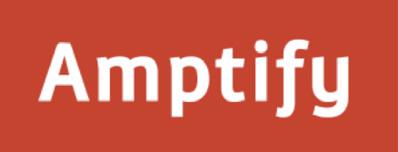
Sontro Hearing Aid Set-Up, Auditory Training & Hearing Coach

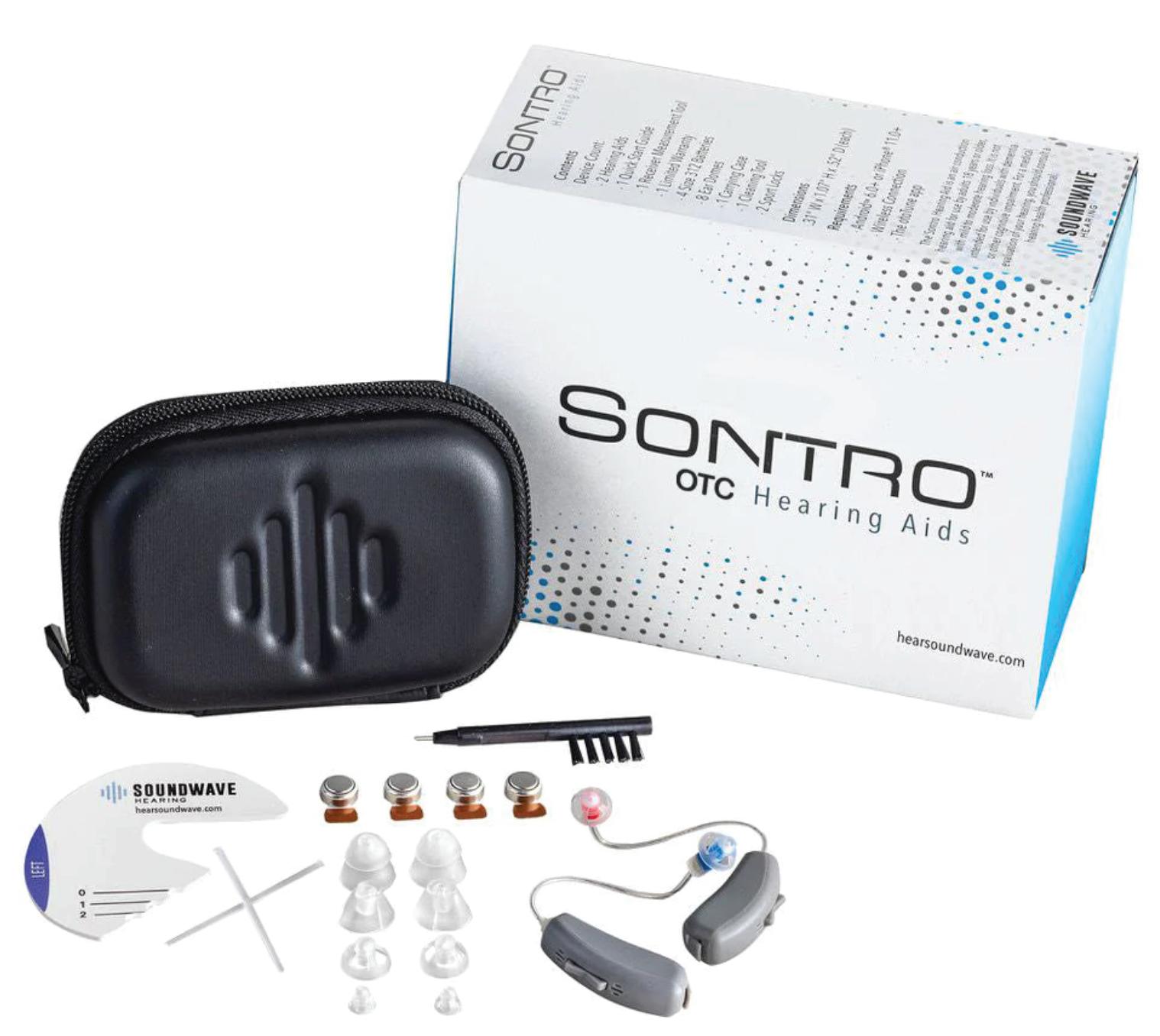

• MSRP $999, earn $200 gross profit on each sale of the Sontro OTC Hearing Aid.
• In stock, order now!
• Order Sontro OTC Hearing Aids and Marketing Materials from PBA Customer Care, 1-800-333-8097


